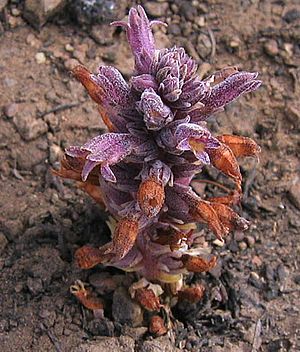Chaparral broomrape facts for kids
Quick facts for kids Chaparral broomrape |
|
|---|---|
 |
|
| Conservation status | |
| Scientific classification | |
| Genus: |
Orobanche
|
| Species: |
bulbosa
|
| Synonyms | |
|
Aphyllon tuberosum |
|
The Orobanche bulbosa is a unique plant often called the chaparral broomrape. It's a special kind of plant that lives in the chaparral areas of California and Baja California. Think of chaparral as a type of shrubland, a dry place with lots of bushes.
This plant is a parasite. This means it doesn't make its own food like most plants do. Instead, it attaches itself to the roots of other plants, usually a shrub called chamise. It then "borrows" all the nutrients and water it needs from its host plant.
About the Chaparral Broomrape
What Does It Look Like?
The chaparral broomrape grows from a thick root. It has a lumpy, twisted base that looks a bit scaly. From this base, a stem grows straight up. It can reach a height of about 30 centimetres (12 in), which is about the length of a ruler.
This plant is quite unusual because it doesn't have any leaves. It also doesn't have chlorophyll, which is the green stuff that helps most plants make food from sunlight. Because of this, the chaparral broomrape isn't green at all! It's usually dark purple or almost black. If you look closely, you might see tiny whitish bumps with small hairs on its stem.
Its Flowers and Seeds
The flowers of the chaparral broomrape grow in a tight cluster. This cluster looks like a spike or a pyramid and usually has more than 20 flowers. Each flower is shaped like a tube and is about 1 and 2 centimetres (0.4 and 0.8 in) long. They can be yellow or purple.
After the flowers bloom, the plant produces a fruit called a capsule. Inside this capsule are many tiny seeds, ready to start new plants.


